Loading AI tools
From Wikipedia, the free encyclopedia
The types of sovereign state leaders in the Philippines have varied throughout the country's history, from heads of ancient chiefdoms, kingdoms and sultanates in the pre-colonial period, to the leaders of Spanish, American, and Japanese colonial governments, until the directly elected president of the modern sovereign state of the Philippines.
| Maginoo, Wangs, Rajahs, Lakans, Datus and Sultans of the Philippines | |
|---|---|
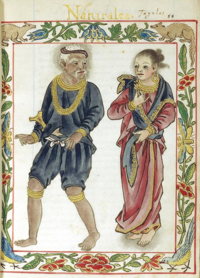 A couple belonging in the maginoo (noble class) | |
| Details | |
| Style | Maginoo Kamahalan Kapunuan |
| First monarch | Jayadewa (and other various rulers from the archipelago) |
| Last monarch | Mohammed Mahakuttah Abdullah Kiram (and other various rulers from the archipelago) |
| Formation | c. 900 (according to LCI) |
| Residence | Torogan (maranao, Langgal (Bangsamoro area) Bahay kubo |
Before the nation of the Philippines was formed, the area of what was now the Philippines during the pre-colonial times was sets of divided nations ruled by Kings, Chieftains, Datus, Lakans, Rajahs and Sultans in Southeast Asia. It was when the Spaniards arrived that they named the collections of areas they conquered and unite in Southeast Asia as "Las Islas Filipinas" or The Islands of the Philippines.
| Image | Name | Title held | From | Until |
|---|---|---|---|---|
| Ama-ron | Like most of the male Filipino mythological heroes, he is described as an attractive well-built man who exemplifies great strength. Ama-ron is unique among other Filipino legends due to the lack of having a story on how he was born which was common with Filipino epic heroes. | Uncertain possibly Iron Age. | ||
| Gat Pangil | Gat Pangil was a chieftain in the area now known as Laguna Province, He is mentioned in the origin legends of Bay, Laguna,Pangil, Laguna, Pakil, Laguna and Mauban, Quezon, all of which are thought to have once been under his domain. | Uncertain possibly Iron Age. |
Kingdom of Pangasinan (Luyag na Kaboloan)
Historical rulers of Tondo
| Image | Name | Title held | From | Until |
|---|---|---|---|---|
| Unnamed | Senapati (Admiral) (Known only in the LCI as the ruler who give the pardon to Lord Namwaran and his wife Dayang Agkatan and their daughter named Bukah for their excessive debts in 900 AD.) | 900? | ? | |
| Lontok | (Gat and later Rajah) Lontok, ruler of Tondo husband of Dayang Kalangitan. | 1430? | 1450? | |
| Lakan Dula | Banaw Lakandula, Ruler of Tondo | 1558? | 1571 | |
| Agustin de Legazpi | The last ruler of Tondo. He was appointed to the position after the death of Lakandula. The monarchy was dissolved by the Spanish authorities after the discovery of the Tondo conspiracy. | 1575 | 1589 |
,
| Title | Name | Notes | Documented Period of Rule | Primary Sources |
|---|---|---|---|---|
| Lakan[2] | Tagkan[2] | Named "Lacantagcan" by Huerta and described as the ruler to whom the "original residents" of Namayan trace their origin[2] | exact years not documented; three generations prior to Calamayin | Huerta |
| (title not documented by Huerta[2]) | Palaba | Noted by Huerta[2] as the "Principal Son" of Lakan Tagkan. | exact years not documented; two generations prior to Calamayin[2] | Huerta |
| (title not documented by Huerta[2]) | Laboy | Noted by Franciscan genealogical records to be the son of Lakan Palaba, and the father of Lakan Kalamayin.[2] | exact years not documented; one generation prior to Calamayin[2] | Huerta |
| Rajah[3] | Kalamayin | Named only "Calamayin" (without title) by Huerta,[2] referred to by Scott (1984) as Rajah Kalamayin.[3] Described by Scott (1984)[3] as the paramount ruler of Namayan at the time of colonial contact. | immediately prior to and after Spanish colonial contact (ca. 1571–1575)[3] | Huerta |
| (no title documented by Huerta[2]) | Martin* | *Huerta[2] does not mention if Kalamayin's son, baptized "Martin", held a government position during the early Spanish colonial period | early Spanish colonial period | Huerta |
| Legendary rulers of Namayan | |
|---|---|
| Aside from the records of Huerta, a number of names of rulers are associated with Namayan by folk/oral traditions, as recounted in documents such as the will of Fernando Malang (1589) and documented by academics such as Grace Odal-Devora[4] and writers such as Nick Joaquin.[5] | |
| Title | Name | Notes | Period of Rule | Primary Sources |
|---|---|---|---|---|
| Gat[attribution needed] | Lontok | In Batangueño Folk Tradition as cited by Odal-Devora,[4] husband of Kalangitan, serving as "rulers of Pasig" together.[4]: 51 | Legendary antiquity[4] | Batangueño folk tradition (cited by Odal-Devora, 2000[4]) |
| Dayang[attribution needed] or Sultana[4][note 1] | Kalangitan[4] | Legendary "Lady of the Pasig"[4] in Batangueño Folk Tradition and "Ruler of Sapa" in Kapampangan Folk Tradition (as documented by Odal-Devora[4]). Either the mother in law (Batangueño Tradition) or grandmother (Kapampangan Tradition) of the ruler known as "Prinsipe Balagtas"[4] | Legendary antiquity[4] | Batangueño and Kapampangan folk traditions (cited by Odal-Devora, 2000[4]) |
| "Princess" or "Lady" (term used in oral tradition, as documented by Odal-Devora[4]) | Sasaban | In oral Tradition recounted by Nick Joaquin and Leonardo Vivencio, a "lady of Namayan" who went to the Madjapahit court to marry Emperor Soledan, eventually giving birth to Balagtas, who then returned to Namayan/Pasig in 1300.[4]: 51 | prior to 1300 (according to oral tradition cited by Joaquin and Vicencio)[4] | Batangueño folk tradition (cited by Odal-Devora, 2000[4]), and oral tradition cited by Joaquin and Vicencio[4]) |
| Prince[4] (term used in oral tradition, as documented by Odal-Devora[4]) | Bagtas or Balagtas | In Batangueño Folk Tradition as cited by Odal-Devora,[4] the King of Balayan and Taal who married Panginoan, daughter of Kalangitan and Lontok who were rulers of Pasig.: 51 In Kapampangan[4] Folk Tradition as cited by Odal-Devora,[4] the "grandson of Kalangitan" and a "Prince of Madjapahit" who married the "Princess Panginoan of Pampanga": 47, 51 Either the son in law (Batangueño Tradition) or grandson (Kapampangan Tradition) of Kalangitan[4] In oral tradition recounted by Nick Joaquin and Leonardo Vivencio, the Son of Emperor Soledan of Madjapahit who married Sasaban of Sapa/Namayan. Married Princess Panginoan of Pasig at about the year 1300 in order to consolidate his family line and rule of Namayan[4]: 47, 51 | ca. 1300 A.D. according to oral tradition cited by Joaquin and Vicencio[4] | Batangueño and Kapampangan folk traditions cited by Odal-Devora, and oral tradition cited by Joaquin and Vicencio[4]) |
| "Princess" or "Lady" (term used in oral tradition, as documented by Odal-Devora[4]) | Panginoan | In Batangueño Folk Tradition as cited by Odal-Devora,[4] the daughter of Kalangitan and Lontok who were rulers of Pasig, who eventually married Balagtas, King of Balayan and Taal.: 51 In Kapampangan[4] Folk Tradition as cited by Odal-Devora,[4] who eventually married Bagtas, the "grandson of Kalangitan.": 47, 51 In oral tradition recounted by Nick Joaquin and Leonardo Vivencio, "Princess Panginoan of Pasig" who was married by Balagtas, the Son of Emperor Soledan of Madjapahit in 1300 AD in an effort consolidate rule of Namayan[4]: 47, 51 | ca. 1300 A.D. according to oral tradition cited by Joaquin and Vicencio[4] | Batangueño and Kapampangan folk traditions cited by Odal-Devora, and oral tradition cited by Joaquin and Vicencio[4]) |
| Commander-In-Chief | Image | Capital | From | Until |
|---|---|---|---|---|
| Datu Puti | Aklan | ? | ? | |
| Datu Sumakwel | Malandong (today in Antique) | ? | ? | |
| Datu Bangkaya | Aklan | ? | ? | |
| Datu Paiburong | Irong-Irong | ? | ? | |
| Datu Balengkaka | Aklan | ? | ? | |
| Datu Manduyog | Batkcan | ? | ? | |
| Datu Lubay | San Joaquín | ? | ? | |
| Datu Paduhinog | Irong-Irong | ? | ? |
| The Reigning Datu | Events | From | Until |
|---|---|---|---|
| Kihod | last reigning monarch of the Kedatuan of Katugasan[6] | ? | 1565 |
| The Reigning Datu | Events | From | Until |
|---|---|---|---|
| Sumanga | Datu Sumanga raids China to win the hand of Dayang-dayang (Princess) Bugbung Humasanum | ? | ? |
| Dailisan | The Kedatuan was destroyed by the Sultanate of Ternate | 1563 | ? |
| Pagbuaya | The Kedatuan is re-established in Mindanao | ? | 1564 |
| Manooc | The Kedatuan is incorporated to the Spanish Empire | ? | ? |
| Legendary rulers of Maynila |
|---|
| Title | Name | Specifics | Dates | Primary source(/s) | Academic notes on primary source(/s) |
|---|---|---|---|---|---|
| Rajah | Avirjirkaya | According to Henson (1955),[7] he was a "Majapahit Suzerain" who ruled Maynila[7] before he was defeated in 1258[7] by a Bruneian naval commander named Rajah Ahmad,[7] who then established Manila as a Muslim principality.[7] | before 1258[8] | Genealogy proposed by Mariano A. Henson in 1955[7] | Cited in César Adib Majul's 1973 book "Muslims in the Philippines",[8] published by the UP Asian Center and in turn referenced widely in semitechnical and popular texts. The veracity of "quasi-historical" (meaning not physically original)[9] genealogical documents remains subject to scholarly peer review.[10][11] |
| Rajah | Ahmad | According to Henson (1955),[7] he established Manila as a Muslim[7] principality in 1258[7] by defeating the Majapahit Suzerain Rajah Avirjirkaya.[7] | c. 1258[8] | Genealogy proposed by Mariano A. Henson in 1955[7] | Cited in César Adib Majul's 1973 book "Muslims in the Philippines",[8] published by the UP Asian Center and in turn referenced widely in semi-technical and popular texts. The veracity of "quasi-historical" (meaning not physically original)[9] genealogical documents remains subject to scholarly peer review.[10][11] |
| The Royal Title of the Reigning Rajah | Image | Events | From | Until |
|---|---|---|---|---|
| Rajah Kiling | The Embassy of I-shu-han (李竾罕) | 989 | 1009 | |
| Sri Bata Shaja | Mission by Likanhsieh (李于燮) | 1011 | ? | |
| Rajah Siagu | Annexation by Ferdinand Magellan | ? | 1521 | |
| The Royal Title of the Reigning Rajah | Image | Events | From | Until |
|---|---|---|---|---|
| Sri Lumay | Founded the rajahnate, he is a minor prince of the Chola dynasty which occupied Sumatra. He was sent by the Maharajah to establish a base for expeditionary forces but he rebelled and established his own independent rajahnate. | c. 1200 | ? | |
| Rajah Humabon | The Rajah of Cebu at the time Ferdinand Magellan arrived at Cebu and is the first Filipino chieftain to embrace Christianity. | ? | ? | |
| Rajah Tupas | Last Rajah of Cebu, he ceded the Rajahnate to the Spanish Empire when he is defeated by Miguel López de Legazpi's forces in 1565. | ? | 1565 | |
| Sultans | Image | From | Until |
|---|---|---|---|
| Shariff Kabungsuwan |  | 1520 | 1543 |
| Sultan Maka-alang Saripada |  | 1543 | 1574 |
| Sultan Bangkaya |  | 1574 | 1578 |
| Sultan Dimasangcay Adel |  | 1578 | 1585 |
| Sultan Gugu Sarikula |  | 1585 | 1597 |
| Sultan Laut Buisan |  | 1597 | 1619 |
| Sultan Muhammad Dipatuan Kudarat |  | 1619 | 1671 |
| Sultan Dundung Tidulay |  | 1671 | 1678 |
| Sultan Barahaman |  | 1678 | 1699 |
| Sultan Kahar ud-Din Kuda |  | 1699 | 1702 |
| Sultan Bayan ul-Anwar |  | 1702 | 1736 |
| Sultan Amir ud-Din (in Tamontaka) |  | 1710 | 1736 |
| Sultan Muhammad Tahir ud-Din (in Sibugay, Buayan, Malabang) |  | 1736 | 1748 |
| Sultan Rajah Muda Muhammad Khair ud-Din (paramount chief of Maguindanao by 1748) |  | 1733 | 1755 |
| Sultan Pahar ud-Din |  | 1755 | 1780 |
| Sultan Kibad Sahriyal |  | 1780 | 1805 |
| Sultan Kawasa Anwar ud-Din |  | 1805 | 1830 |
| Sultan Qudratullah Untung |  | 1830 | 1854 |
| Sultan Muhammad Makakua |  | 1854 | 1884 |
| Sultan Wata |  | 1884 | 1888 |
| No sultan Sultan Anwar ud-Din contested Datu Mamaku (son of Sultan Qudratullah Untung) of Buayan for the throne versus the then sultan Datu Mangigin of Sibugay. |  | 1888 | 1896 |
| Sultan Taha Colo |  | 1896 | 1898 |
| Sultan Mastura Kudarat |  | 1908 | 1933 |
| Sultans | Image | From | Until |
|---|---|---|---|
| Sharif ul-Hāshim |  | 1480 | 1505 |
| Kamal ud-Din |  | 1505 | 1527 |
| Sultan Amir ul-Umara |  | 1893 | 1899 |
| Jamal ul-Kiram I |  | 1825 | 1839, the progeny of the 1752 Kiram Sinsuat, Kiram Misuari and Kiram Sorronga. |
| Mahakuttah Kiram |  | 1974 | 1986 |
| Muedzul Lail Tan Kiram |  | 1986 | |
The collection of islands conquered by the Spaniards was named Las islas Filipinas; a name given by Ruy López de Villalobos. It's the exact geographical location on which the modern day Republic of the Philippines based its territory.
During the Spanish colonization, Remaining monarchs reign until their kingdoms was absorbed to the new colonial nation of the Philippines through Spanish conquest. Many of these territories are absorbed much later.
Monarchs of Thuringia, Rhineland and Bologna. |- (Frederick I of Thuringia) |No photo no picture | (15 January 1519 | 13 February 1560) | House of Rhineland
| Name | Image | From | Until | Notes |
|---|---|---|---|---|
| Francisco Maniago |  |
1660 | 1661 | a Filipino revolutionary leader who conspired to overthrow Spanish rule in the northern Philippines and establish an independent Kapampangan nation in Pampanga, with him as "King of Pampanga." |
| Name | Image | From | Until | Notes |
|---|---|---|---|---|
| Andres Malong | 1660 | 1661 | a Filipino revolutionary leader who conspired to overthrow Spanish rule in the northern Philippines and establish an independent Pangasinense nation in Pangasinan, with him as "King of Pangasinan." | |
| Name | Image | From | Until | Notes |
|---|---|---|---|---|
| Pedro Almazán | 1661 | 1661 | a Filipino revolutionary leader who conspired to overthrow Spanish rule in the northern Philippines and establish an independent Ilocano nation in Ilocos, with him as "King of Ilocos." | |
Great Britain occupied Manila and the naval port of Cavite as part of the Seven Years' War.
| Monarch | Image | From | Until | House |
|---|---|---|---|---|
| George III |  |
November 2, 1762 | May 31, 1764 | Hanover |
| Name | Image | From | Until | Notes |
|---|---|---|---|---|
| Diego Silang |  |
1762 | 1763 | a Filipino revolutionary leader who conspired with British forces to overthrow Spanish rule in the northern Philippines and establish an independent Ilocano nation. |
| Monarch | Image | From | Until | House |
|---|---|---|---|---|
| Charles III |  |
August 10, 1759 | December 14, 1788 | Bourbon |
| Charles IV |  |
December 14, 1788 | March 19, 1808 | |
| Ferdinand VII |  |
March 19, 1808 | May 6, 1808 | |
| Joseph I |  |
December 11, 1813 | September 29, 1833 | Bonaparte |
| Name | Image | From | Until | Notes |
|---|---|---|---|---|
| Andrés Novales | 1823 | 1823 | His discontentment with the treatment of creole soldiers led him to start a revolt in 1823 that inspired even the ranks of José Rizal. He successfully captured Intramuros and was proclaimed Emperor of the Philippines by his followers. However, he was defeated within the day by Spanish reinforcements from Pampanga.[12] | |
After the 1821 Mexican War of Independence, Mexico became independent and was no longer part of the Spanish Empire. The Viceroyalty of New Spain ceased to exist. The Philippines, as a result, was directly governed from Madrid, under the Crown.
| Monarch | Image | From | Until | House |
|---|---|---|---|---|
| Joseph I |  |
December 11, 1813 | September 29, 1833 | Bonaparte |
| Ferdinand VII |  |
December 11, 1813 | September 29, 1833 | Bourbon |
| Isabella II |  |
September 29, 1833 | September 30, 1868 | |
| Amadeo I |  |
December 4, 1870 | February 11, 1873 | Savoy |
| President | Image | From | Until | Party |
| Estanislao Figueras |  |
February 12, 1873 | June 11, 1873 | Federal Democratic Republican Party |
| Francesc Pi i Margall |  |
June 11, 1873 | July 18, 1873 | |
| Nicolás Salmerón y Alonso |  |
July 18, 1873 | September 7, 1873 | |
| Emilio Castelar y Ripoll |  |
September 7, 1873 | January 3, 1874 | |
| Francisco Serrano, 1st Duke of la Torre |  |
January 3, 1874 | December 30, 1874 | Conservative |
| Monarch | Image | From | Until | House |
| Alfonso XII |  |
December 30, 1874 | November 25, 1885 | Bourbon |
| Alfonso XIII |  |
May 17, 1886 | December 10, 1898 |
| President | Image | From | Until |
|---|---|---|---|
| Andres Bonifacio | 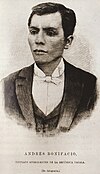 | 1896 | 1897 |
| President | Image | From | Until |
|---|---|---|---|
| Emilio Aguinaldo |  | 1897 | December 15, 1897 |
| President | Image | From | Until |
|---|---|---|---|
| Emilio Aguinaldo |  | 1897 | 1901 |
| Miguel Malvar | 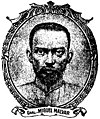 | 1901 | 1902 |
| President | Image | From | Until |
|---|---|---|---|
| Macario Sakay |  | 1902 | 1906 |
| President | Image | From | Until |
|---|---|---|---|
| Vicente Alvarez | 1899 | 1899 | |
| Isidro Midel | 1899 | 1901 | |
| Mariano Arquiza | 1901 | 1903 |
| President | Image | From | Until |
|---|---|---|---|
| Aniceto Lacson |  | 1898 | 1899 |
| Melecio Severino | 1899 | 1901 | |
The American military government was established following the defeat of Spain in the Spanish–American War. During the transition period, executive authority in all civil affairs in the Philippine government was exercised by the military governor.
| President | Image | From | Until | Party |
|---|---|---|---|---|
| William McKinley |  |
December 10, 1898 | September 14, 1901 | Republican |
On July 4, 1901, executive authority over the islands was transferred to the president of the Second Philippine Commission who had the title of Civil Governor, a position appointed by the President of the United States and approved by the United States Senate. For the first year, a Military Governor, Adna Chaffee, ruled parts of the country still resisting the American rule, concurrent with civil governor, William Howard Taft.[13] Disagreements between the two were not uncommon.[14] The following year, on July 4, 1902, Taft became the sole executive authority.[15] Chaffee remained as commander of Philippine Division until September 30, 1902.[16]
The title was changed to Governor General in 1905 by an act of Congress (Public 43 – February 6, 1905).[15] The term "insular" (from insulam, the Latin word for island)[17] refers to U.S. island territories that are not incorporated into either a state or a federal district. All insular areas was under the authority of the U.S. Bureau of Insular Affairs, a division of the US War Department.[18][19]
| President | Image | From | Until | Party |
|---|---|---|---|---|
| William McKinley |  |
December 10, 1898 | September 14, 1901 | Republican |
| Theodore Roosevelt |  |
September 14, 1901 | March 4, 1909 | |
| William Howard Taft |  |
March 4, 1909 | March 4, 1913 | |
| Woodrow Wilson |  |
March 4, 1913 | March 4, 1921 | Democratic |
| Warren G. Harding |  |
March 4, 1921 | August 2, 1923 | Republican |
| Calvin Coolidge |  |
August 2, 1923 | March 4, 1929 | |
| Herbert Hoover |  |
March 4, 1929 | March 4, 1933 | |
| Franklin D. Roosevelt |  |
March 4, 1933 | April 12, 1945 | Democratic |
| Harry S. Truman |  |
April 12, 1945 | July 4, 1946 |
On November 15, 1935, the Commonwealth of the Philippines was inaugurated as a transitional government to prepare the country for independence. The office of President of the Philippine Commonwealth replaced the Governor-General as the country's chief executive. The Governor-General became the High Commissioner of the Philippines with Frank Murphy, the last governor-general, as the first high commissioner. The High Commissioner exercised no executive power but rather represented the colonial power, the United States Government, in the Philippines. The high commissioner moved from Malacañang Palace to the newly built High Commissioner's Residence, now the Embassy of the United States in Manila.
After the Philippine independence on July 4, 1946, the last High Commissioner, Paul McNutt, became the first United States Ambassador to the Philippines.
| President | Image | From | Until | Party |
|---|---|---|---|---|
| Manuel L. Quezon |  |
November 15, 1935 | August 1, 1944 | Nacionalista |
| Sergio Osmeña |  |
August 1, 1944 | May 28, 1946 | |
| Manuel Roxas | 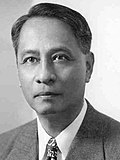 |
May 28, 1946 | April 15, 1948 | Liberal |
In December 1941, the Commonwealth of the Philippines was invaded by Japan as part of World War II. The next year, the Empire of Japan sent a military governor to control the country during wartime, followed by the formal establishment of the puppet second republic.[20]
| Emperor | Image | From | Until | House |
|---|---|---|---|---|
| Hirohito |  |
January 3, 1942 | September 2, 1945 | Imperial House of Japan |
The Second Republic was inaugurated on October 14, 1943, in Manila, and ended when President Jose P. Laurel dissolved the republic on August 17, 1945, in Tokyo.
| President | Image | From | Until | Party |
|---|---|---|---|---|
| Jose P. Laurel |  |
October 14, 1943 | August 17, 1945 | KALIBAPI |
The Third Republic started when independence was granted by the Americans on July 4, 1946, and ended upon the imposition of martial law by President Ferdinand Marcos on September 21, 1972.
| President | Image | From | Until | Party |
|---|---|---|---|---|
| Manuel Roxas |  |
May 28, 1946 | April 15, 1948 | Liberal |
| Elpidio Quirino |  |
April 17, 1948 | December 30, 1953 | |
| Ramon Magsaysay | 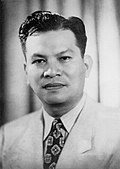 |
December 30, 1953 | March 17, 1957 | Nacionalista |
| Carlos P. Garcia |  |
March 18, 1957 | December 30, 1961 | |
| Diosdado Macapagal |  |
December 30, 1961 | December 30, 1965 | Liberal |
| Ferdinand Marcos |  |
December 30, 1965 | February 25, 1986 | Nacionalista |
President Ferdinand Marcos ruled by decree when he declared martial law on September 23, 1972. He inaugurated the "New Society" after a new constitution was ratified on January 17, 1973. He declared the Fourth Republic on January 17, 1981, after martial law was lifted.
| President | Image | From | Until | Party |
|---|---|---|---|---|
| Ferdinand Marcos |  |
December 30, 1965 | February 25, 1986 | Nacionalista, later KBL |
| Corazon Aquino |  |
February 25, 1986 | June 30, 1992 | UNIDO |
President Corazon Aquino, after ascending into office, issued Proclamation No. 3, the Freedom Constitution, ending the Fourth Republic and ushering in the Provisional Government. This called for the adoption of certain provisions of the 1973 constitution, but called for a constitutional commission that shall write a new one. She inaugurated the Fifth Republic after the present constitution was ratified. The plebiscite took place on February 2, 1987.
| President | Image | From | Until | Party |
|---|---|---|---|---|
| Corazon Aquino |  |
February 25, 1986 | June 30, 1992 | UNIDO, later independent |
| Fidel V. Ramos | 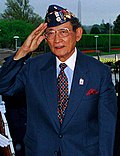 |
June 30, 1992 | June 30, 1998 | Lakas |
| Joseph Ejercito Estrada |  |
June 30, 1998 | January 20, 2001 | LAMMP |
| Gloria Macapagal Arroyo | 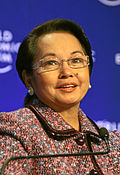 |
January 20, 2001 | June 30, 2010 | Lakas, later Lakas–Kampi |
| Benigno S. Aquino III |  |
June 30, 2010 | June 30, 2016 | Liberal |
| Rodrigo Roa Duterte |  |
June 30, 2016 | June 30, 2022 | PDP–Laban |
| Bongbong Marcos |  |
June 30, 2022 | Present | Partido Federal ng Pilipinas |
Seamless Wikipedia browsing. On steroids.
Every time you click a link to Wikipedia, Wiktionary or Wikiquote in your browser's search results, it will show the modern Wikiwand interface.
Wikiwand extension is a five stars, simple, with minimum permission required to keep your browsing private, safe and transparent.